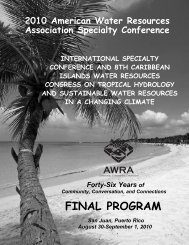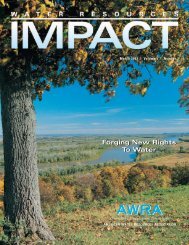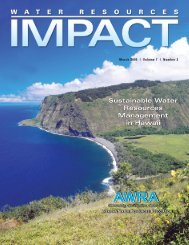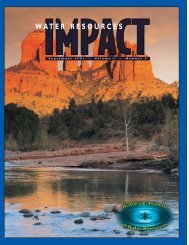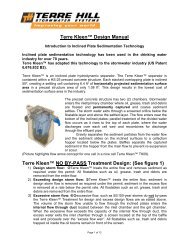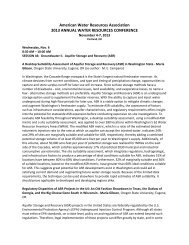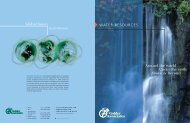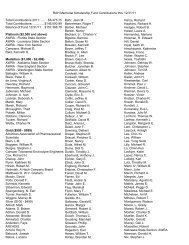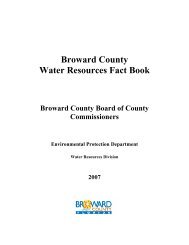Legacy Phosphorus and Harmful Algal Blooms in Lake Erie
Legacy Phosphorus and Harmful Algal Blooms in Lake Erie
Legacy Phosphorus and Harmful Algal Blooms in Lake Erie
Create successful ePaper yourself
Turn your PDF publications into a flip-book with our unique Google optimized e-Paper software.
<strong>Legacy</strong> <strong>Phosphorus</strong> <strong>and</strong> <strong>Harmful</strong><br />
<strong>Algal</strong> <strong>Blooms</strong> <strong>in</strong> <strong>Lake</strong> <strong>Erie</strong><br />
R. Peter Richards, David B. Baker, Remegio Confesor<br />
National Center for Water Quality Research<br />
Heidelberg College<br />
Tiff<strong>in</strong>, Ohio 44883<br />
St. Louis, MO American Water Resources Association March 26, 2013
Topics<br />
<strong>Legacy</strong> P?<br />
Recent Issues <strong>in</strong> <strong>Lake</strong> <strong>Erie</strong><br />
P Levels <strong>and</strong> Trends <strong>in</strong> the Watershed<br />
P management <strong>in</strong> the face of legacy P
Background: NCWQR Monitor<strong>in</strong>g<br />
Rais<strong>in</strong><br />
<strong>Lake</strong> <strong>Erie</strong><br />
Ontario<br />
Vermilion<br />
Gr<strong>and</strong><br />
Indiana<br />
Michigan<br />
Ohio<br />
<strong>Lake</strong><br />
<strong>Erie</strong><br />
Pennsylvania<br />
New York<br />
Maumee<br />
S<strong>and</strong>usky<br />
Cuyahoga<br />
N<br />
0 40 80 120 Kilometers<br />
W<br />
E<br />
S<br />
Autosamplers at USGS stations, 3 samples per day<br />
Sediment, nutrients, major ions<br />
1974 to present, ~15,000 samples per station<br />
Recent extensive soil test<strong>in</strong>g <strong>in</strong> S<strong>and</strong>usky watershed
I. <strong>Legacy</strong> P? What does that mean?!!
<strong>Legacy</strong> P?<br />
<strong>Legacy</strong> pollutants: PCBs, DDT, lead from<br />
Roman smelters…<br />
OK, compounds no longer be<strong>in</strong>g released…<br />
But what does “legacy P” mean?<br />
Soil pool <strong>and</strong> <strong>in</strong>-channel <strong>and</strong> floodpla<strong>in</strong><br />
storage<br />
Essentially any nutrients applied before this<br />
year (<strong>and</strong> maybe some from this year too)
<strong>Legacy</strong> P – How Much?<br />
More common to f<strong>in</strong>d budgets than <strong>in</strong>ventories…<br />
Soil Total P: ~1000 ppm or 2000 lb/acre or 2245 kg/ha*<br />
~4,000,000 tons <strong>in</strong> Maumee River watershed – <strong>in</strong> top 8 <strong>in</strong>ches!<br />
Compare soil test P (median S<strong>and</strong>usky watershed): 55 kg/ha<br />
Compare annual crop yield removal<br />
l ~11 kg/ha -> ratio is 200:1<br />
Compare annual tributary export<br />
l ~1.7 kg/ha -> ratio is 1350:1<br />
…Lots!<br />
But <strong>in</strong> many different forms<br />
* One source: http://www.soils.wisc.edu/extension/area/2003/Bundy_stp.pdf
II. <strong>Lake</strong> <strong>Erie</strong> Recent History
June 22, 1969
“I heard <strong>Lake</strong> <strong>Erie</strong> is the place fish go<br />
to die.”<br />
‐ Johnny Carson, 1976<br />
Gail Hesse, OLEPF
“They’ll walk on<br />
their f<strong>in</strong>s <strong>and</strong> get<br />
woefully weary <strong>in</strong><br />
search of some<br />
water that isn’t so<br />
smeary. I hear th<strong>in</strong>gs<br />
are just as bad up <strong>in</strong><br />
<strong>Lake</strong> <strong>Erie</strong>.”<br />
http://en.wikipedia.org/wiki/File:The_Lorax.jpg<br />
Gail Hesse, OLEPF
What was wrong with <strong>Lake</strong> <strong>Erie</strong>?<br />
HABs<br />
Hypoxia
<strong>Lake</strong> <strong>Erie</strong> Total <strong>Phosphorus</strong> Load<strong>in</strong>g, 1967-2008<br />
30,000<br />
25,000<br />
Annual load, metric tons<br />
20,000<br />
15,000<br />
10,000<br />
TP target load<br />
11,000 metric tons<br />
5,000<br />
0<br />
1967<br />
1969<br />
1971<br />
1973<br />
1975<br />
1977<br />
1979<br />
1981<br />
1983<br />
1985<br />
1987<br />
1989<br />
1991<br />
1993<br />
1995<br />
1997<br />
1999<br />
2001<br />
2003<br />
2005<br />
2007<br />
Direct Po<strong>in</strong>t Sources Atmospheric Deposition <strong>Lake</strong> Huron Input<br />
Indirect Po<strong>in</strong>t Sources Tributary Monitored NPS only Adjustment for Unmonitored Area<br />
Load, all sources<br />
Data from Dave Dolan, UWGB
Central Bas<strong>in</strong> Oxygen Depletion Rate<br />
Us<strong>in</strong>g tentative alternate method, Ruc<strong>in</strong>ski et al. (<strong>in</strong> prep)<br />
3.0<br />
Water Column Oxygen Dem<strong>and</strong><br />
mg/L/month<br />
2.5<br />
2.0<br />
1.5<br />
1.0<br />
0.5<br />
y = -0.283x + 564.87<br />
R 2 = 0.729<br />
y = 0.0777x - 154.94<br />
R 2 = 0.689<br />
?<br />
0.0<br />
1986 1988 1990 1992 1994 1996 1998 2000 2002 2004 2006<br />
Dan Ruc<strong>in</strong>ski, LimnoTech
Microcystis <strong>in</strong> <strong>Lake</strong> <strong>Erie</strong><br />
The Microcystis-Anabaena bloom of 2009 was the<br />
largest <strong>in</strong> recent years <strong>in</strong> our sampl<strong>in</strong>g region<br />
…until 2011<br />
2011
Shift <strong>in</strong> lake response<br />
WHY?<br />
Total <strong>Phosphorus</strong> Concentration<br />
µg/L<br />
40<br />
35<br />
In-lake TP<br />
y = 0.0009x - 17.622<br />
R 2 = 0.0745<br />
30<br />
p
III. Watershed Status <strong>and</strong> Trends
Forms of <strong>Phosphorus</strong><br />
(Total) Dissolved P<br />
• 90% of it is Dissolved<br />
Reactive P (DRP)<br />
Particulate P (PP)
III B. Watershed Status <strong>and</strong> Trends, PP
Show<strong>in</strong>g Success of BMPs for<br />
PP<br />
Log(PP)<br />
1970<br />
1975<br />
1980overall<br />
1985<br />
1990<br />
1995<br />
2000<br />
bdif<br />
ANCOVA<br />
Year as categorical variable<br />
y=mx+b+bdif year<br />
Sum of bdif year is 0<br />
Look at bdif vs year<br />
Log(Flow)
Show<strong>in</strong>g Success of BMPs for<br />
PP<br />
Coefficients of: lnPP on YR<br />
Level of YR Coefficient Level of YR Coefficient Level of YR Coefficient<br />
1975 0.2039 1987 -0.1595 1996 0.0344<br />
1976 0.1540 1988 0.2823 1997 0.0503<br />
1977 0.3750 1989 0.0897 1998 -0.0309<br />
1978 -0.0302 1990 0.1940 1999 -0.1648<br />
1982 -0.0099 1991 0.0546 2000 -0.1679<br />
1983 0.0754 1992 -0.0894 2001 -0.3439<br />
1984 0.0150 1993 0.0036 2002 -0.2071<br />
1985 0.1150 1994 0.0451 2003 -0.3136<br />
1986 0.1923 1995 -0.0063 2004 -0.3611
Show<strong>in</strong>g Success of BMPs for<br />
PP<br />
p
III C. Watershed Status <strong>and</strong> Trends, DRP
Importance of DRP<br />
(Total) Dissolved P<br />
• 90% of it is Dissolved<br />
Reactive P (DRP)<br />
• DRP is 100% bioavailable<br />
Particulate P (PP)<br />
• ~30% bioavailable<br />
• Tends to settle to bottom
Maumee Trends 1975-2012:<br />
DRP Loads<br />
Maumee River 1975-2012<br />
Dissolved Reactive <strong>Phosphorus</strong> Load (tonnes)<br />
500<br />
450<br />
400<br />
350<br />
300<br />
250<br />
200<br />
150<br />
100<br />
50<br />
0<br />
1973 1978 1983 1988 1993 1998 2003 2008 2013<br />
Fall<br />
Spr<strong>in</strong>g<br />
Summer<br />
W<strong>in</strong>ter<br />
Poly. (Fall)<br />
Poly. (Spr<strong>in</strong>g)<br />
Poly. (Summer)<br />
Poly. (W<strong>in</strong>ter)<br />
Big seasonal differences!
Importance of DRP<br />
Dissolved P<br />
• 90% DRP<br />
• DRP is 100% bioavailable for<br />
algal growth<br />
Maumee River, Bioavailable <strong>Phosphorus</strong> Load<strong>in</strong>g<br />
Bioavailabe Soluble Phos.<br />
Bioavailable Particulate Phos.<br />
Particulate<br />
• ~30% bioavailable<br />
• Tends to settle to bottom<br />
Bioavailable <strong>Phosphorus</strong><br />
Loads, metric tons<br />
2000<br />
1600<br />
1200<br />
800<br />
400<br />
0<br />
1975 1980 1985 1990 1995 2000 2005<br />
Water Year
III D. What does legacy P have to do<br />
with this?
Risk of <strong>Phosphorus</strong> Loss<br />
Source factors<br />
l<br />
l<br />
<strong>Legacy</strong> P pool<br />
Timimg <strong>and</strong> Placement of new P<br />
Transport factors<br />
l<br />
l<br />
L<strong>and</strong>scape position<br />
BMPs <strong>and</strong>
Soil test trends <strong>in</strong> P, NW Ohio<br />
Long term phosphorus soil test trends for NW Ohio<br />
120<br />
lbs/ac Bray P1<br />
100<br />
80<br />
60<br />
40<br />
20<br />
OSU Lab<br />
Logan<br />
OSU Lab<br />
Calhoun<br />
DRP FWMC<br />
A&L<br />
Lab<br />
0<br />
1960 1965 1970 1975 1980 1985 1990 1995 2000 2005
P concentration <strong>in</strong> soil<br />
83%<br />
Fertilizer Rate<br />
18%<br />
50%<br />
Critical<br />
Level<br />
48%<br />
33%<br />
Ma<strong>in</strong>tenance<br />
Level<br />
34%<br />
17%<br />
Buildup<br />
Range<br />
Ma<strong>in</strong>tenance<br />
Range<br />
Soil Test Level<br />
Drawdown<br />
Range<br />
Corn & soybeans<br />
Wheat
Negative watershed mass balance!<br />
P 2 O 5 , thous<strong>and</strong> short tons per year<br />
800<br />
600<br />
400<br />
200<br />
MI‐OH‐ON<br />
Fertilizer<br />
Manure<br />
Crop Removal<br />
0<br />
1970 1975 1980 1985 1990 1995 2000 2005 2010<br />
IPNI Tom Bruulsma
<strong>Legacy</strong> P…<br />
Does not predict PP or DRP trends<br />
Is not particularly high, as measured by STP<br />
Appears to be decl<strong>in</strong><strong>in</strong>g <strong>in</strong> last decade
Management changes…<br />
Broadcast fertilization without <strong>in</strong>corporation<br />
Fall application<br />
Soil P stratification<br />
Tile dra<strong>in</strong>age efficiency <strong>in</strong>creases<br />
Soil health issues?
Verdict(?)…<br />
Changes <strong>in</strong> management are more important<br />
than <strong>in</strong>creases <strong>in</strong> legacy P <strong>in</strong> underst<strong>and</strong><strong>in</strong>g<br />
<strong>and</strong> deal<strong>in</strong>g with <strong>Lake</strong> <strong>Erie</strong>’s problems.
IV. Manag<strong>in</strong>g that Huge Mass of P
Management<br />
Don’t make th<strong>in</strong>gs worse! Apply<br />
replacement amounts.<br />
Draw down P levels <strong>in</strong> over-enriched soils<br />
Manage transport risk factors to keep legacy<br />
(<strong>and</strong> non-legacy) P under control!<br />
<strong>Legacy</strong> P is a valuable resource until it<br />
leaves the field!
A couple of excellent sources…<br />
http://www.epa.ohio.gov/dsw/lakeerie/<strong>in</strong>dex.aspx
Rock Creek 6/25/06<br />
The End



